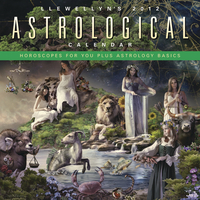The Evolution of a Calendar
Editor’s Note: Please enjoy this guest blog post from Nicole Edman, editor of our Llewellyn’s Astrological Calendar.
On the 80th anniversary of the first Astrological Calendar, I dug through our archives for a few olde-tyme samples to see how the calendar has evolved over the years. And boy was I ever fascinated! I couldn’t lay my hands on our earliest copies, which are from a time long before Llewellyn was purchased and moved to Minnesota. Below are images and summaries of the calendars from 1945, 1975, and 1995.
1945

Here are a few images of the 1945 calendar, the year World War II ended. The calendar was titled as the Star Book of the Year back then, and the grids were fairly simple, with just dates and Moon phases. No room to jot down your dentist appointment, though! The astrological element shone on the tops of the month spreads, which featured Sun sign profiles and yearly horoscopes, sparse Moon data, and an inspirational column. The cover features a simple illustration of the twelve astrological symbols in a circle—a theme that was repeated for many years and reborn in the early 2000s.
1975

By 1975, the Moon data had migrated into the grids, which were now easier to use, and the top pages added sign-by-sign monthly horoscopes—much more detailed than a short yearly summary for your sign. The top pages also included two horoscope charts for the date of the New and Full Moon. The cover featured a color photographic treatment of space, a fairly new and popular concept during that time.
1995

Moving into the 1990s, the cover now features an illustration of a night goddess ushering in the twelve astrological symbols. Here we see the influence of astrology over astronomy. The illustration theme carries over to the top pages, which feature depictions of each Sun sign, as well monthly horoscopes and a tiny ephemeris chart. The grids are beginning to look more familiar and informative, with major aspects printed alongside Moon phases and signs and planetary transits. It is in this example that we really see the two main aims of the Astrological Calendar come to the forefront: information and amusement for lay astrologers and rich data for serious astrologers.
Llewellyn’s 2012 Astrological Calendar features the art of computer-generated art of fantasy artist John J. Blumen. We are proud to offer different styles and depictions of astrological art every year and hope you enjoy this year’s product. Our grids are now easier to use, with more white space for jotting notes as well as important daily aspects and lunar information. The monthly horoscopes provide a quick snapshot of what the month will be like for you and any tips to help you navigate it. And don’t forget the extensive primer and ephemeris tables in the back of the calendar! Even seasoned astrologers find these pages to be a handy reference, always available and always accurate.











Thanks Anna ! This is delightful and informative. The calendars through the years have always had interesting artwork, and in the 1970’s the artwork became quite beautiful as well as the printing technology caught up.